JAXA Astronaut Activity Report, June 2007
Last Updated: August 17, 2007
This is JAXA's Japanese astronaut primary activity report for June 2007.
1J Mission Space Shuttle Crew Training
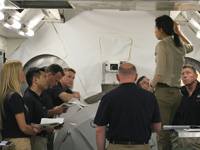
1J Mission crew members inside Pressurized Module trainer, listening to an overview of Kibo
The Tsukuba Space Center (TKSC) welcomed the 1J Mission (STS-124) crew members including astronaut Akihiko Hoshide. The crew members participated in training sessions for the 1J Mission’s tasks of assembling and activating the Kibo Pressurized Module (PM).
The IJ crew members underwent training on activating the PM. In addition, they participated in training on operating Kibo’s primary systems, including the Command and Data Handling (C&DH) system, the Electrical Power System (EPS), the Thermal Control System (TCS), and the Environmental Control and Life Support System (ECLSS). The crew members then reviewed the procedures of entering the PM, as well as rack transfer operations. The full-scale PM trainer and a virtual reality (VR) system were used during the training sessions.
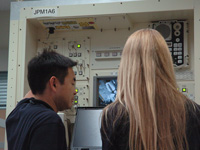
Astronauts Hoshide (left) and Nyberg (right) using the simulator to simulate operating the Kibo Remote Manipulator System (RMS), Kibo’s robotic arm.
In addition, astronauts Hoshide and Karen Nyberg trained on the Kibo Remote Manipulator System (RMS), Kibo’s robotic arm.
During the training sessions, the activities focused on the overview of the RMS and its deployment operations, which the crew members will conduct during the mission. During launch, the RMS will be folded and secured to the PM.
Towards the end of the training session, the astronauts simulated on-orbit RMS deployment, cooperating with JAXA’s flight controllers.
Water survival training at Neutral Buoyancy Laboratory (NBL)
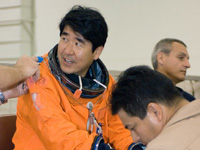
Astronaut Doi donning his orange flight suit
Astronaut Doi participated in water survival training using the water pool at the Neutral Buoyancy Laboratory (NBL) in NASA Johnson Space Center (JSC). All of the 1J/A Mission (STS-123) crew members participated in the water survival training.
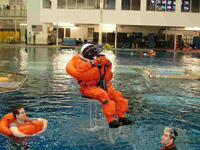
Astronaut Doi being hoisted out of the water during the rescue simulation
The purpose of this training is to provide the crew members with the necessary survival skills to survive in the oceans until being rescued. If a flight anomaly occurs with the space shuttle during the launch phase of the mission, the crew members would bail out of the shuttle. Because the shuttle flies over the Atlantic Ocean immediately after launch, the crew members are expected to land in the ocean after bailing out. This is why the training uses the NBL water pool.
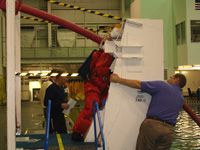
Astronaut Doi during the bailout training exercise
Astronaut Doi underwent the entire escape sequence that included how to get out from under the parachute after landing in the water and how to inflate his small inflatable raft. In addition, he participated in the evacuation training by using the escape pole extending out of a mock-up of the space shuttle’s escape hatch.
Crew Equipment Interface Test (CEIT) for Kibo
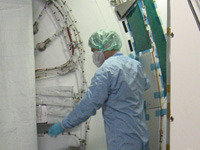
Astronaut Hoshide looking over hardware
At NASA Kennedy Space Center (KSC), the 1J/A Mission (STS-123) crew members, including Astronaut Doi, and the 1J Mission (STS-124) crew members, including Astronaut Hoshide separately participated in the Crew Equipment Interface Tests (CEIT) for both the Kibo Pressurized Module (PM) and the Experiment Logistics Module Pressurized Section (ELM-PS).
In the CEIT, crew members have the opportunity for hands-on experience with the various equipment related to their missions.
During the tests, the crew members checked accessibility of equipment that will be stored in the ELM-PS and used during the Intra-Vehicular Activity. The equipment includes panels that will be temporarily stored in the PM before the racks are relocated from the ELM-PS to the PM. In addition, they reviewed the equipment that will be used during the Extra Vehicular Activity. The equipment that was being checked during the test includes the Common Berthing Module (CBM) covers for ELM-PS and PM external television cameras, and the Multi-Layer Insulation (MLI) covers for trunnion/keel pins that secure the PM to the payload bay of the Space Shuttle during launch.







